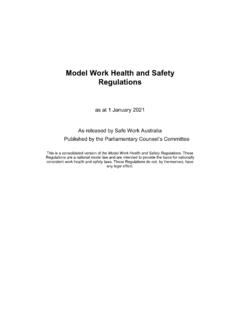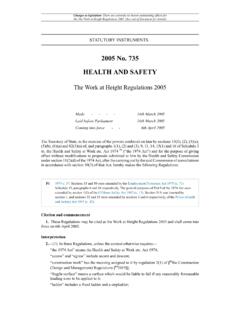Transcription of Guide to Scaffolds and Scaffolding - Safe Work Australia
1 1 Safe Work Australia Contact Information Phone 1300 551 832 | Email | Web [Multi-Vol. Set] 978-1-74361-769-4 [PDF] 978-1-74361-770-0 [DOCX]This Guide provides information on specific types of Scaffolds and Scaffolding and practical examples of ways you can control some of the risks associated with them. It is part of a series of guidance material and should be read and used together with the General Guide for Scaffolds and Scaffolding work which includes information on risk management as well as advice on planning, erecting, altering, dismantling and working with Scaffolds and the following material: Guide to suspended (swing stage) Scaffolds Guide to scaffold Inspection and maintenance, and Information Sheet: Tower and mobile information for Scaffolding work near overhead electric lines is also available in the Information Sheet.
2 Scaffolding work near overhead electric addition to the risk control measures listed in this Guide , the Scaffold Inspection Checklist included in the Guide to scaffold inspection and maintenance may also be adapted to suit the needs of your business and the particular Scaffolds in scaffoldA birdcage scaffold is an independent scaffold consisting of more than two rows of standards in both directions connected by ledgers and transoms (see Figure 1). It is mainly used for work carried out on a single level, for example ceilings. You should refer to the designer s or manufacturer s specifications when erecting and dismantling birdcage Scaffolds made from modular Scaffolding .
3 The following risk control measures should be implemented for birdcage Scaffolds made from tube and coupler Scaffolding : Only use birdcage scaffold to support formwork if it has been specifically designed for this purpose. Provide longitudinal bracing or a tied face at every third longitudinal row of standards. Brace the outside row of standards on each face and each third row internally with longitudinal bracing. Provide transverse bracing at every fourth bay on the ends of the scaffold. Consider using elevating work platforms to assist with erecting or dismantling birdcage fall arrest system is generally not a suitable risk control measure for the erection or dismantling of perimeter and birdcage Scaffolds .
4 You should refer to the General Guide for Scaffolds and Scaffolding work for further information on fall arrest systems.! Guide TO Scaffolds AND SCAFFOLDINGFIGURE 1 Bird cage scaffold2 JULY 2014 Guide TO Scaffolds AND SCAFFOLDINGT restle scaffoldA trestle scaffold is a scaffold assembled from prefabricated trestles, braces and accessories. Trestle Scaffolds , for example A-frame (see Figure 2) and H-frame trestle Scaffolds , are commonly used by bricklayers, plasterers and painters and for general fit-out and finishing work. Trestle Scaffolds generally do not require a licensed scaffolder to erect or Scaffolds should be erected and dismantled by a competent person in a progressive way to ensure both the installer s safety and the stability of the overall structure.
5 Braces should be attached to the trestles in accordance with the manufacturer s or supplier s instructions. As the height of trestles increase, there is a greater need to provide lateral stability to the trestles. A trestle scaffold should be stable and erected on a suitable foundation to ensure it can safely carry and distribute loads like materials and workers evenly to each trestle. Measures to control instability and stop possible toppling can include using ties to a permanent structure or using Scaffolds should: have barriers or edge protection installed where the potential fall would result in injury to people using the scaffold or the fall area contains hazards sharp objects like steel reinforcing bars support the relevant live load or duty rating not exceeding load limit Note: The full width of a trestle should be fully planked, irrespective of the duty rating.
6 Have scaffold planks that are uniform and in a serviceable condition no splits, cracks, knots or bends, overhang their end supports between 150 250 mm and are secured against uplift have a horizontal work platform at least 450 mm wide. On sloping or uneven ground use a trestle that incorporates height adjustment. Bricks or blocks should not be used as soleplates have a safe means of entry and exit by secured ladders or from the building if approximately level with the platform have a safe means to load material onto the working platform use mechanical means or if this is not practicable, pass do not throw material up to the working platform, and not be used by multiple people in restricted work areas at the same time so as not to overload 450 mm.
7 2 plank bracing systems for tubular trestle Scaffolds are manufactured from light materials and are easily damaged by misuse or abuse so care should be taken during installation and dismantling. Under no circumstances should anyone climb the braces or trestles. Cross-braces on trestle Scaffolding do not satisfy the requirements for edge protection. Hung scaffoldA hung or hanging scaffold is an independent scaffold that hangs from another structure but is not capable of being raised or lowered when in use (see Figure 3).!!FIGURE 2 A-frame trestle scaffold3 JULY 2014 Guide TO Scaffolds AND SCAFFOLDINGThe following control measures should be implemented for a hung scaffold: The hung scaffold should be designed by a competent person and verification obtained that the structure that is to support the hung scaffold is capable of bearing the design load.
8 The Scaffolding plan should include information about the position of the check couplers. If a cantilevered suspension rig is to be used, information should be included on how the rig is to be constructed and secured. Standards on a hung scaffold should be tension spliced or bolted with rated spigot connection as per the manufacturer s specifications. Each vertical hanging tube should be provided with check couplers at the suspension points and underneath the platform or according to the manufacturer s pole scaffoldA single pole scaffold consists of a single row of standards connected by ledgers (see Figure 4).
9 Putlogs are fixed to the ledgers and built into the wall of the building or single pole scaffold is dependent upon the structure against which it is placed for support. It is important that no components of this type of scaffold are removed until the scaffold is being 3 Hung scaffold!FIGURE 4 Single pole scaffold 4 JULY 2014 Guide TO Scaffolds AND SCAFFOLDINGS uspended (swing stage) scaffoldA suspended scaffold incorporates a suspended platform capable of being raised or lowered when in use. An example of a suspended scaffold is a swing-stage information is in the Guide to suspended (swing stage) and mobile scaffoldsA tower scaffold is an independent scaffold consisting of four vertical standards connected longitudinally and transversely or two frames in plan connected transversely to create a scaffold of one mobile scaffold is a tower scaffold mounted on information is in the Information Sheet.
10 Tower and mobile for demolition workAt a minimum, heavy or special duty (see below) scaffold should be used during demolition work to contain dislodged materials or to provide a safe working platform and edge protection for which affect the stability of a scaffold for demolition work include: the load imposed by demolished material dislodged onto the scaffold wind forces acting on containment sheeting on the scaffold face water retention in containment sheeting by capillary attraction progressive removal of building elements affecting the lateral stability of the upper portion of the scaffold, and progressive removal of ties and dismantling of the following risk control measures should be implemented when using Scaffolds for demolition work.

















